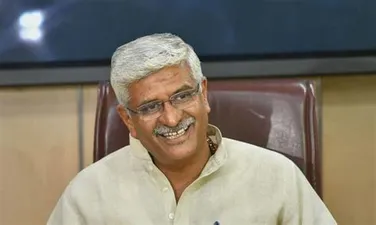
Union Minister of Jal Shakti Gajendra Singh Shekhawat said that India is implementing two flagship missions to ensure universal access to sanitation and drinking water.
While addressing the third plenary meeting of the United Nations 2023 Water Conference, Shekhawat highlighted the priorities, policy and actions of India that are linked to achieving the Sustainable Development Goal 6 targets. Shekhawat said that a unified ministry of Jal Shakti was created by PM Narendra Modi in 2019 to give greater coherence and synergy to water management. He called political will, public financing, partnerships, people’s participation and persuasion as five principles for ensuring sustained behavioural change.
“To give greater coherence and synergy to water management in India, a unified Ministry of Jal Shakti was created in 2019 by our Prime Minister Narendra Modi. The five principles that form the bedrock of our actions are political will, public financing, partnerships, people’s participation and persuasion for ensuring sustained behavioural change,” Shekhawat said.
“We have committed investments of more than 240 billion dollar in the water sector through government resources, in partnership with private innovators, start ups, and water-user association. India is implementing two flagship missions to ensure universal access to sanitation and drinking water,” he added.
Union Minister for Jal Shakti said that Water Life Mission which is synonymous aims to achieve safe and affordable drinking water in the rural household by 2024. He said that India with a commitment to successfully implement the 50 billion dollar program is poised to achieve SDG 6.1 before 2030.
“Jal Jeevan Mission or Water Life Mission which is synonymous with the SDG goal 6.1, aims to achieve safe and affordable drinking water in the rural household by 2024, manage own in-village water supply systems, developing robust institutions and assist capacity building of stakeholders on significance of water for improvement in quality of life. With a commitment to successfully implement this ambitious 50 billion dollar program in mission mode, we are poised to achieve SDG 6.1 well before 2030,” Shekhawat said.
He said, “India’s Swachh Bharat mission or Clean India Mission milestone was reached in 2019, when the country was declared open defecation free.” He stated that India in its journey to achieve SDG 6.2, since 2014 has built over 105 million toilets, and transformed sanitation habits through mass-scale behaviour change of more than 600 million Indians.
In his address, he assured about India’s commitment, support and partnership in the collective endeavor to achieve the important goals of the Water Action Decade. Gajendra Singh Shekhawat said that India’s national mission for Clean Ganga or Namami Gange was recently recognised by the UN in the Convention of Biodiversity conference COP15 at Montreal as one of the top 10 World Restoration Flagships to revive the natural world.
In his address at the UN 2023 Water Conference, Shekhawat stressed that the mission has created a paradigm shift in river rejuvenation, pollution abatement, conservation of ecosystems and holistic approach to river basin management.
He further said, “Arth Ganga, a model of circular economy fully aligns with SDG goals 6.3 and 6.6 with 6(b) in creating environmentally friendly sustainable practices of resource management by local communities for water security. India is also implementing the largest dam rehabilitation programme in the world, to build climate resilience critical water storage infrastructure.”
Shekhawat said that India is among the largest users of groundwater in the world. He noted that India is making efforts to restore groundwater level and creating mindful communities by combining demand and supply side interventions through village water security plans.
“Due to our unique geography, India is among the largest users of groundwater in the world. However, today we are making efforts to restore groundwater level and creating mindful communities by combining demand and supply side interventions through village Water security plans, inculcating behavioural changes on water usage and conservation at the grass-root level, financing these plans through incentives and convergence of existing programmes. This has led to creating greater community ownership in the equitable management of water at local level,” Shekhawat said.
He said that PM Modi launched the Jal Shakti Abhiyan in 2019 to promote water conservation and recharge, including rainwater harvesting. This is an annual campaign and communities are encouraged and supported in the restoration of traditional water bodies and rejuvenation of rivulets, water conservation and rainwater harvesting, reuse and recharge of bore wells, watershed development and intensive afforestation.
Shekhawat said PM Modi at COP26 introduced the concept of LiFE or “Lifestyle for Environment”. He said that the concept was translated into an action agenda with the launch of “Mission LiFE” by UN Secretary-General Antonio Guterres and PM Modi in October 2022.
Shekhawat stressed that the initiative is aimed at encouraging people to pick pro-planet sustainable choices in their daily lives, to live sustainably and reduce our environmental footprint, and is driven by the concept of ‘Reduce, Reuse and Recycle’. He called on all the delegates to adopt mission LiFE in this international decade for action on water.















